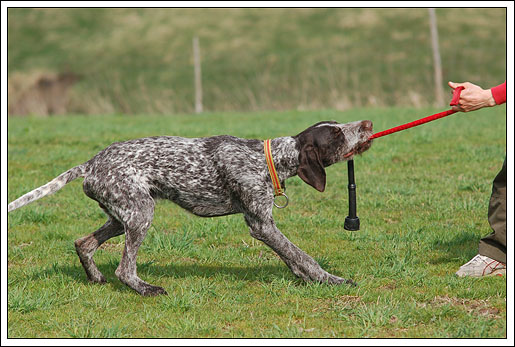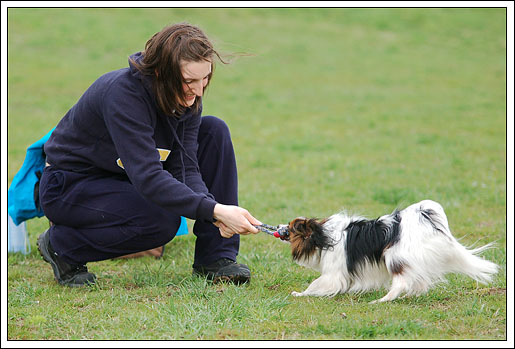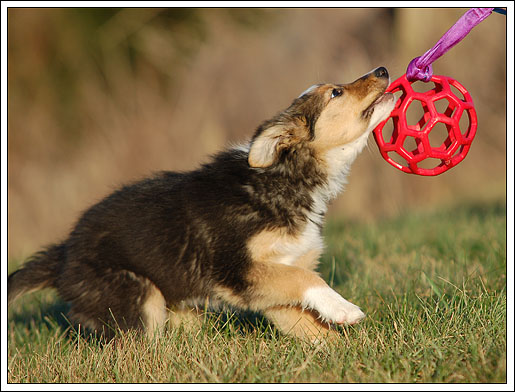Thanks to the very reinforcing comment from Russia in the last blog post, I decided to translate my latest Swedish blog post into English for my foreign readers. It’s about developing your dog’s love of tugging:
As we are seeing a lot of new students right now, we talk a lot about developing rewards and mainly tugging. It’s very hard to train a dog without rewards and we feel that you need more than one good reward. With our own dogs, we focus a lot on developing both food and play as a reward. This is something that we also want to share with our students. Food is a really good reinforcer if you want to give many rewards in a short period of time, maybe without dog breaking it’s position at all. Food is also often calming and is appropriate when teaching precision. Play is a good reinforcer when you want speed and intensity, or if you want to throw the reward a long way. Play increases arousal in the dog and brings out new sides to the dog compared to food. It’s therefore a great advantage to be able to switch between food and play depending on where you want to go with your training.

We often prefer tugging to chasing a toy, but often use both in combination. If the dog likes to chase a toy, but won’t tug, we try to develop the dog’s love for tugging so that the dog wants to end the chasing by grabbing, pulling and winning. At many times, we want the dog to grab the toy immediatly when it’s presented (or when the dog is cued to ”get it”). It could be because we want the dog to drive straight to the handler after a turn on the agility course, or to get full speed and focus towards the handlers left side on a recall. Games of chasing, where a toy is dragged on the ground by a piece of rope, can be a really good reinforcer in other situations, mainly as a jackpot for focus and endurance. But even then, the intensity and joy will be better if the dog really wants to grab the toy.
Not all dogs do automatically like a game of tug. It’s a reward that needs to be developed in many dogs. Our opinion is that it always is worth to teach the dog to play if you want to get the most out of the dog you have. The dog might not have to enjoy tugging as much as food, but he should play with high intensity when we present a toy. For some dogs, tugging will be the ”motor” in training, the thing that makes training worth while for the dog. For other dogs, food will be the ”motor”, but they can still learn to really engage in tugging between food rewards, so that you’re able to gain from all the great things that come with tugging. And with time and good training, the dog’s priorities might change.
Shejpa was a dog that often would not tug. Not while food was around, not out doors, not if she wasn’t in the mood… I worked a lot with her tugging and it’s really good now. I can use 90 percent tugging in training (but she still needs that occational chicken neck to keep the engine running) and most of the time, you can’t tell that it’s a ”trained” tug. I’m convinced that she wouldn’t run half as fast if I didn’t use tugging in training. I can also see how tugging is getting more and more reinforcing for her, that she really does enjoy it more and more.

When developing our young dogs, we always have a goal in the back of our heads. We want the dog to grab the toy immediatly when it’s presented (or cued), tug intensly with weight shift and a straight top line (from head to tail). We want to be able to be passive (moving equipment around, talking to the instructor or student, filling up with more treats) and still have the dog tugging on the toy. If we tell the dog to ”out”, we want the dog to drop the toy. If we throw a toy or let the dog win while tugging, we want the dog to come right into us and deliver it to hand (we use a hand touch for this). At the same time, we want the dog to have fun and find tugging reinforcing.
This is a long term goal. It does not mean that all playing must look that way from the start. If the dog prefers to just chase a toy, that’s where we’ll begin. If we have to be very active to get the dog tugging, we will be. Our first priority is to get the dog to have fun with a toy. I think that good dog trainers have the ability to have a lot of fun with the dog, while reinforcing behaviors that will bring him closer to the long term goal. To reinforce behaviors while playing does not mean that you have to click and treat. It could be that you get more intense when the dog pulls harder, that you let the dog win when he weight shifts. You can find out what your dog really finds reinforcing when playing and use that to reinforce glimpses of what you’d like to see more of in the future. If you reinforce increased intensity in that way, your dog will be more intense and then also enjoying tugging more.
We feel that playing is addictive. You can starve a dog and get him to work better for treats, but it doesn’t work that way with playing. Play regularly with your dog to increase his love for playing. But don’t play for long. Always end the game when it’s at it’s best and make sure that you are ending the game, not the dog. You want the dog to be a bit disappointed when the game ends, dancing after you to get it to start again. That might mean that the first sessions are so short that the dog doesn’t even get to grab the toy, just chase it with high intensity, before it goes away.

Pick the right opportunity to start playing with your dog. You don’t want to present a toy and fail in getting the dog to play. It’s a common misstake to give up way to fast if the dog isn’t immediatly turned on to the game. Some dogs are slow starters in the beginning, but don’t give up. Don’t try to force the toy on the dog, rather act as if the toy is really valuable to you and you’re having a lot of fun with it. Experiment with different ways to get your dog started. Pick really fun toys and make sure that there is a piece of rope or a long handle on it, so that you can drag it along the ground and get it away from your body. Turn away from the dog and drag the toy away.
You can absolutely use food to reinforce tugging and transfer the value from one reward to another. It does require good dog training skills and it isn’t my first choice. It is really important that the criteria is raised fairly fast and that the dog is really engaging in the game before the food is presented. To use few, but really attractive food rewards is better than to use many pieces of low quality food. Timing is also really important; make sure that the dog is really into the game of tugging before the reward marker is used. If you use food to reinforce play, it’s still important for you to be active and have fun while playing. You want the dog to find out how fun playing can be even without food rewards.
This blog post could go on for ever. I’m making it shorter by ending with a few tips in a list. These points has helped me to increase tug drive in my own dogs:
- Start all your training sessions with a game of tug.
- Tug with your dogs for every 3-5 pieces of food you give him in training
- Put running around with the toy on cue and use it to reward good tugging
- Let the dog tug with you before he can have his food at every meal
- Play in many different settings
- Find really good toys (sheep skin, real fur, braided fleece etc.)
- Snatch the toy away from the dog if he looses the toy. Tease him with it for a while before he can have it again.
- Check out Susan Garretts ”How to create a motivational toy”.
- Put sticky food (raw tripe, minced meat, liver pâté or similar) into a wool stocking and let your dog chase it. As he grabs the toy he’ll get a taste sensation directly in his mouth. (NB! Make sure your dog doesn’t get hold of the toy at any time, as it can be dangerous if he tries to swallow it).
- Encourage interest in objects, grabbing, holding and weight shifting in your regular training sessions – train picking things up, retrieving, pulling on dead objects etc. and reward with food. But don’t forget the unrestrained, fun play. This is just a complement.
- Don’t ever give your dog a treat if he refuses to play (rather put the dog away if you decide to give up).
- Get your dog aroused before presenting the toy. Do restrained recalls, let the dog chase you or wrestle with your dog (if he likes to).
- Believe that it really is possible to get your dog to tug. It is!



Kathie R ,
Hi Fanny, I’m so glad you’re back! I’ve been checking your site daily, hoping for some more training tips. I am really interested in your post on increasing play drive. Do you think you can teach play drive to a 5-year-old dog who doesn’t appear interested in toys and tugging? I’m working on a utility dog title in the states and trying to motivate my dog. He does like treats and will run across the ring to get them, but not so with toys. Hoping to use some of your tips to try to develop some play drive with him. Thanks!
Fanny ,
Hi Kathie,
I’m happy to see that people are actually checking the blog out daily! I promise to update more often.
I’m sure that you can teach your 5-year-old dog to enjoy play. I got my cairn terrier to start enjoying toys for the first time in his life at age 9. With much less sofisticated methods then outlined here (I really just shaped a retrieve with him, did some flyball and then, one day, found my old dog playing with a tennis ball on his own in the back yard!)
Roseanna ,
Hi Fanny!
Great post. I have been thinking a lot about rewards lately. I really need to use more play rewards so your post is very helpful. Especially in regards to teaching tug.
Foundations For a Great Retrieve at Fanny’s Clicker Dog Blog ,
[…] Video « Increasing Play Drive in Your Dog […]
Kathie R ,
Hi again Fanny,
I think we’re making progress with the tugging 🙂 I followed your link to Susan Garretts page regarding how to begin teaching the dog to tug. And, for the past couple weeks have been working with that in the house. At first he would just take it in his mouth. Now, today when I brought it out he really grabbed hold of it and didn’t want to let go! That’s real progress for him. Our next step is to take it to the training building and see if he’s interested in it there – unless there’s a step in between that I should be doing. Please let me know if you think the next step should be something different.
Thanks!
Linn Ahlbom ,
Thank you for this great post! I will have to think of better ways to train tug with my dog — and shape him to grab the toy further from my hand (he likes to hold the toy right next to my hand for some reason), currently he prefers food to tug but I really would find it useful to reward with play as well as food.
Sarah Stuurman ,
Hi Fanny,
Thanks for writing such a superb post! I too follow your website and LOVE reading your stuff and watching you train your dogs 🙂 I wish I had had this post last summer and fall when I was working on play drive with my english cocker… but I figured it out (discovered a lot of what you wrote about on my own) and I now have a crazy tugging dog with great desire and drive for toys, games, retrieving, etc.
My previous dog was not very toy motivated so I used a lot of food with her. This dog was very good at training ME so I became pretty much a food-only trainer. I was determined not to let that happen with my cocker; it was hard for me but soooooo worth it. A great “side effect” of working on tugging and playing with her was that *I* loosened up and started to have way more fun training. I think my training skills have improved a lot too!
Thanks for being so generous with your knowledge 🙂
Dee Mullins ,
Hi Fanny,
Oh, I’m so glad I read this article!! I have a mini aussie that is in beginning agility and we are in the process of using a toy drive instead of always depending on a treat. He loves to play – but not all the time on the agility field – especially when he knows I have treats. I’m taking your suggestions and will keep in mind that it takes time! Thanks so much for your suggestions and your experience!
Katy ,
Hi Fanny,first I have to say that my english is very bad because I realy need it since leaving school. I´m working wtih my 4 years old Jack Russell Terrier in Obedience – now in germans class 2!
He is rewarding by food or playing with me. Now I´m searching for Toys that you are using with your dogs during trainingsessions. My favorite is for instance the jollyball with a rope. Did you make it on your own…? I´ve never seen it before!
Thanks and gretings from Germany
Katy
Rebecca ,
Hi Fanny,
My name is Rebecca and i want to know Do pets have a paw preference like people have a hand preference?
Thanks,
Rebecca
Uppdaterad: Dagens träningspass | Hallens Hund & Träning´s blogg ,
[…] http://www.fannygott.com/increasing-play-drive-in-your-dog […]
13 Simple Steps to Improve Your Dogs Recall - Puppy Leaks ,
[…] that instant excitement of going outdoors by playing with your dog beforehand. The more you actively play with your dog and engage them the more attentive they’ll be when it comes to training. […]
A Game of Tug is The Best Training Reward I've Found – Puppy Leaks ,
[…] your dog isn’t too keen on play I’d suggest reading this great article on how to increase your dogs play drive that has plenty of strategies to make your dog interested in […]
Frances ,
Thank you soooooo much for your help! I have an agility dog in training and outr teacher keeps telling me if I want to compete Riley MUST play tug! I have found it really hard to play with her as the treats the toy as a mouse and paws at it before giving up! I will take on board your advice and hope we get better 🙂
Fanny Gott ,
I’m glad you found it helpful! And it is great that she does interact with the toy in some way. Let her treat is as a mouse and make it a fun game for her to chase it. I wouldn’t care so much about her actually tugging, but more about her really enjoying the interaction with the toy and you – to begin.
Bored Cesar ,
Great post! Thank you for sharing it.
13 étapes simples pour améliorer le rappel de votre chien – Petit Chien ,
[…] excitation instantanée de sortir dehors en jouant avec votre chien au préalable. Plus vous jouez et engagez activement votre chien, plus il sera attentif à l’entraînement. Tout cela fait […]
Dog training with toys- Step by step guide. - Your Dog Cares ,
[…] fannygott.com […]
Un juego de remolque es la mejor recompensa de entrenamiento que he encontrado – Woof ,
[…] está muy entusiasmado con el juego, le sugiero que lea estos fantásticos artículos sobre cómo aumentar el número de sus perros que juegan y ¿Tiene usted un perro al que no le gusta jugar ? Ambos tienen muchas estrategias para ayudar a […]
13 Simple Steps to Improve Your Dogs Recall – Dog Toys ,
[…] that instant excitement of going outdoors by playing with your dog beforehand. The more you actively play with your dog and engage them the more attentive they’ll be when it comes to training. It’s all […]
Top 7 How To Teach Your Dog To Drive Lastest Updates 09/2022 ,
[…] Read More […]